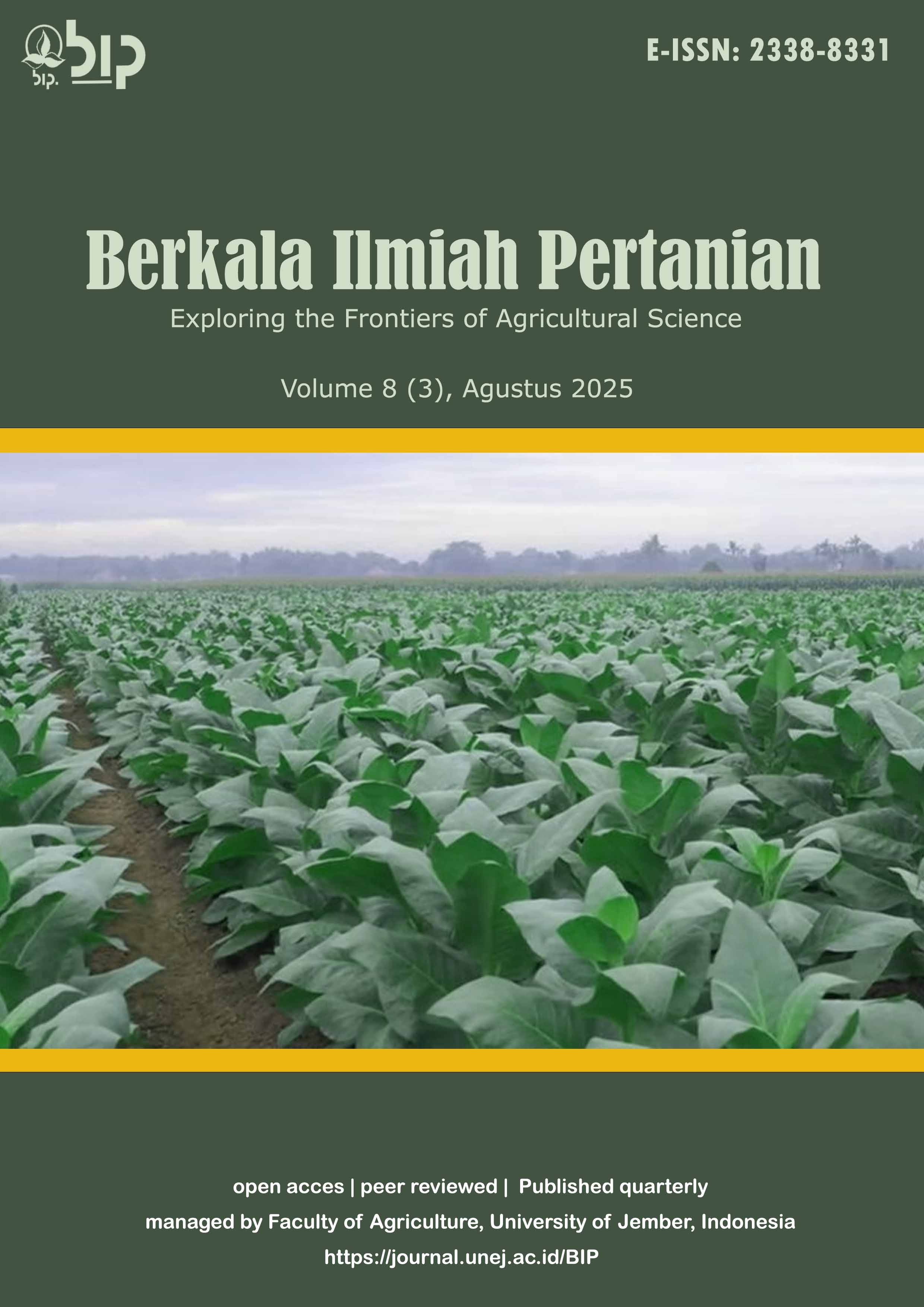Pemanfaatan Biochar Tempurung Kelapa terhadap Pertumbuhan dan Produksi Kailan (Brassica oleracea L.)
DOI:
https://doi.org/10.19184/bip.v8i3.53715Keywords:
Biochar tempurung kelapa, kailan, pupuk NPKAbstract
Kailan (Brassica oleracea L.) merupakan sayuran daun bernilai ekonomi tinggi yang banyak dibudidayakan. Namun, produktivitasnya sering terhambat oleh penurunan kualitas tanah akibat penggunaan pupuk sintesis secara berlebihan. Biochar sebagai bahan organik hasil pirolisis biomassa, berpotensi memperbaiki sifat fisik, kimia, dan biologi tanah, sehingga dapat digunakan sebagai alternatif dalam sistem budidaya berkelanjutan. Penelitian ini bertujuan untuk mengevaluasi pengaruh pemberian biochar tempurung kelapa yang dikombinasikan dengan 50% pupuk NPK terhadap pertumbuhan dan hasil tanaman kailan, serta menentukan dosis biochar yang optimal. Penelitian dilaksanakan pada bulan Oktober hingga Desember 2024 menggunakan Rancangan Kelompok Lengkap Teracak (RKLT) dengan lima perlakuan dan lima ulangan. Perlakuan terdiri atas P0 (100% NPK), P1 (50% NPK + 120 g biochar), P2 (50% NPK + 240 g), P3 (50% NPK + 360 g), dan P4 (50% NPK + 480 g) per polybag. Hasil penelitian menunjukkan bahwa perlakuan 50% NPK + 120 g biochar memberikan hasil terbaik pada tinggi tanaman (27,41 cm), jumlah daun (8,87 helai), panjang akar (11,63 cm), dan bobot basah (32,87 g), serta estimasi produksi 3,65 ton/ha. Sementara itu, peningkatan dosis biochar di atas 240 g tidak memberikan hasil lebih tinggi. Kesimpulannya, kombinasi 50% pupuk NPK dan 120 g biochar tempurung kelapa merupakan perlakuan paling efisien dalam meningkatkan pertumbuhan dan hasil tanaman kailan serta mendukung praktik pertanian berkelanjutan.
Downloads
References
Annisa, W., & Setiawati, E. (2020). Benefits of Biochar Compost (BIOCHOM) to Yield Rice Productivity on Tropical Swampland, South Kalimantan, Indonesia. BIO Web of Conferences, 20(01009), 1–4. https://doi.org/10.1051/bioconf/20202001009
Enaime, G., & Lübken, M. (2021). Agricultural waste‐based biochar for agronomic applications. Applied Sciences (Switzerland), 11(19), 1–27. https://doi.org/10.3390/app11198914
Ghorbani, M., Amirahmadi, E., Konvalina, P., Moudrý, J., Bárta, J., Kopecký, M., Teodorescu, R. I., & Bucur, R. D. (2022). Comparative Influence of Biochar and Zeolite on Soil Hydrological Indices and Growth Characteristics of Corn (Zea mays L.). Water (Switzerland), 14(21). https://doi.org/10.3390/w14213506
Herman, W., & Resigia, E. (2018). Pemanfaatan Biochar Sekam dan Kompos Jerami Padi Terhadap Pertumbuhan dan Produksi Padi (Oryza sativa) Pada Tanah Ordo Ultisol. Jurnal Ilmiah Pertanian, 15(1), 42–50. https://doi.org/10.31849/jip.v15i1.1487
Herman, W., Resigia, E., & Syahrial. (2018). Formulasi Biochar dan Kompos Titonia Terhadap Ketersediaan Hara Tanah Ordo Ultisol. Jurnal Galung Tropika, 7(April), 56–63.
Hossain, M. Z., Bahar, M. M., Sarkar, B., Donne, S. W., Ok, Y. S., Palansooriya, K. N., Kirkham, M. B., Chowdhury, S., & Bolan, N. (2020). Biochar and its importance on nutrient dynamics in soil and plant. In Biochar (Vol. 2, Issue 4). Springer Singapore. https://doi.org/10.1007/s42773-020-00065-z
Jabborova, D., Annapurna, K., Paul, S., Kumar, S., Saad, H. A., Desouky, S., Ibrahim, M. F. M., & Elkelish, A. (2021). Beneficial features of biochar and arbuscular mycorrhiza for improving spinach plant growth, root morphological traits, physiological properties, and soil enzymatic activities. Journal of Fungi, 7(7), 1–16. https://doi.org/10.3390/jof7070571
Jing, F., Chen, X., Wen, X., Liu, W., Hu, S., Yang, Z., Guo, B., Luo, Y., Yu, Q., & Xu, Y. (2020). Biochar effects on soil chemical properties and mobilization of cadmium (Cd) and lead (Pb) in paddy soil. Soil Use and Management, 36(2), 320–327. https://doi.org/10.1111/sum.12557
Kabir, E., Kim, K. H., & Kwon, E. E. (2023). Biochar as a tool for the improvement of soil and environment. Frontiers in Environmental Science, 11, 1–17. https://doi.org/10.3389/fenvs.2023.1324533
Losacco, D., Tumolo, M., Cotugno, P., Leone, N., Massarelli, C., Convertini, S., Tursi, A., Uricchio, V. F., & Ancona, V. (2022). Use of Biochar to Improve the Sustainable Crop Production of Cauliflower (Brassica oleracea L.). Plants, 11(1182), 1–18.
Ma, H., Shurigin, V., Jabborova, D., Dela Cruz, J. A., Dela Cruz, T. E., Wirth, S., Bellingrath-Kimura, S. D., & Egamberdieva, D. (2022). The Integrated Effect of Microbial Inoculants and Biochar Types on Soil Biological Properties, and Plant Growth of Lettuce (Lactuca sativa L.). Plants, 11(3), 1–12. https://doi.org/10.3390/plants11030423
Pathak, A., Paul, J., Negi, M. S., Gautam, P., & Pachauri, S. P. (2023). Impact of Crop Residue and Green Manure Management in Rice Crop on Soil Nutrient Dynamics in Tarai Belt of Shivalik Himalaya, India. International Journal of Plant & Soil Science, 35(21), 783–792. https://doi.org/10.9734/ijpss/2023/v35i214045
Rahmayuni, E., Mayangsari, Herman, W., Elfarisna, & Putri, E. L. (2023). Efficiency of Inorganic Fertilizer Utilization with Biofertilizer on the Growth and Production of Soybeans ( Glycine max ( L ). Merrill .). Journal of Land Restoration, 6, 94–99. https://doi.org/10.31186/terra.6.2.94-99 ISSN
Raj, A., Karol, A., Shaji, A., Pandey, R., & Gupta, H. (2023). Biochar: A Comprehensive Overview of Its Role in Soil Health. International Journal of Environment and Climate Change, 13(10), 1621–1628. https://doi.org/10.9734/ijecc/2023/v13i102817
Sarma, B., Gogoi, N., Bharali, M., & Mali, P. (2018). Field evaluation of soil and wheat responses to combined application of hardwood biochar and inorganic fertilizers in acidic sandy loam soil. Experimental Agriculture, 54(4), 507–519. https://doi.org/10.1017/S0014479717000205
Sharma, A., & Chhabra, V. (2024). A Review on the Applications of Biochar in Agricultural Farms: A Low Carbon Emission Technology. Journal of Advances in Biology & Biotechnology, 27(7), 480–492. https://doi.org/10.9734/jabb/2024/v27i71009
Sun, H., Jeyakumar, P., Xiao, H., Li, X., Liu, J., Yu, M., Rana, P. B. J., & Shi, W. (2022). Biochar can increase Chinese cabbage (Brassica oleracea L.) yield, decrease nitrogen and phosphorus leaching losses in intensive vegetable soil. Phyton-International Journal of Experimental Botany, 91(1), 197–206. https://doi.org/10.32604/phyton.2022.016492
Downloads
Published
Issue
Section
License
Copyright (c) 2025 Berkala Ilmiah Pertanian

This work is licensed under a Creative Commons Attribution-NonCommercial 4.0 International License.
Authors who publish with this journal agree to the following terms:
1.Authors retain copyright and grant the journal right of first publication with the work simultaneously licensed under a Creative Commons Attribution-NonCommercial 4.0 International License that allows others to share the work with an acknowledgement of the work's authorship and initial publication in this journal.
2.Authors are able to enter into separate, additional contractual arrangements for the non-exclusive distribution of the journal's published version of the work (e.g., post it to an institutional repository or publish it in a book), with an acknowledgement of its initial publication in this journal.
3.Authors are permitted and encouraged to post their work online (e.g., in institutional repositories or on their website) prior to and during the submission process, as it can lead to productive exchanges, as well as earlier and greater citation of published work (See The Effect of Open Access).




















